Culture
Sculpting God's Image: How Indigenous Faiths Are Resisting Christian Missionaries In Arunachal
Nabaarun Barooah
Feb 04, 2025, 01:32 PM | Updated Mar 03, 2025, 04:31 PM IST
Save & read from anywhere!
Bookmark stories for easy access on any device or the Swarajya app.


The year was 1997, and in the New Changlang area of Arunachal Pradesh, an extraordinary event was taking place.
Tangsa and Nocte tribal members gathered for a painting competition, but this was no ordinary artistic endeavor. They were there to do something unprecedented: draw their god, Rangfrah.
For generations, the Tangsa Tutsa, and Nocte tribes had worshipped Rangfrah without a defined image or idol, though a broader description existed in popular memory.
According to legend, Rangfrah had descended to Earth in human form—known as the First Coming of Rangfrah—to teach humanity lessons about compassion, humility, and the value of sharing.
The deity was described as a figure holding a spear and a Wushu bird, with matted hair and a goatee, his left ear adorned with paddy while his right ear had an earthworm. Yet until that moment in 1997, this existed only in imagination, not in any tangible form.
Behind this endeavour was the Rashtriya Swayamsevak Sangh (RSS).
The painting competition marked a pivotal moment in the tribe's history. After the competition, a painting was selected by the tribal elders, and a marble statue of Rangfrah was commissioned by the RSS, crafted in Jaipur and installed in a newly constructed temple in New Changlang supported by the RSS.
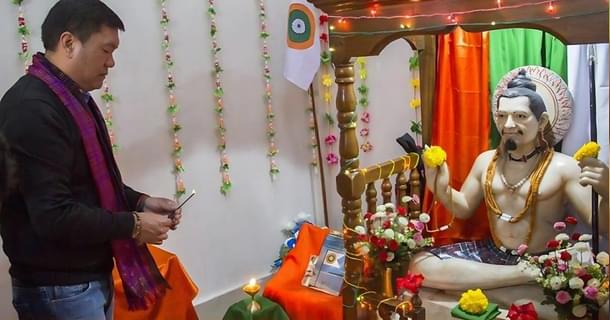
This installation marked what became known as the "Second Coming of Rangfrah," a significant step in materialising the indigenous religion.
This transformation of faith from abstract to concrete form came at a critical time in Arunachal Pradesh's religious landscape. The state had witnessed a dramatic surge in Christian conversions among its indigenous tribes over the decades.
The Problematic History of Evangelisation
Christian conversions in Arunachal Pradesh, part of India's northeastern region, follow a complex history rooted in both colonial influence and later political movements. The Northeast's conversion story is largely shaped by British colonial rule, which introduced a distinct education system aimed at assimilating tribal populations.
Lord Macaulay's education policy, which emphasized English as a medium of instruction, laid the foundation for significant cultural shifts in the region. As the British expanded their influence in the Northeast, they promoted the spread of Christianity, both as a tool for social control and as a means to "civilize" the indigenous populations. Missionaries followed suit, setting up schools and medical facilities in these areas where traditional practices and local religions were deeply rooted.
The British also introduced the Inner Line Permit (ILP) system, which restricted the movement of non-indigenous people into certain regions of Northeast India. This policy was initially designed to protect indigenous cultures from the encroaching influence of mainstream Hindu society and external influences, particularly from British India.
The ILP served as a barrier, keeping outsiders from settling in these remote areas, but also enabled missionaries to focus on specific tribal communities that lacked modern infrastructure and facilities.
The establishment of schools, hospitals, and other essential services played a key role in encouraging conversions, as local people, many of whom had limited access to education and healthcare, found these offerings attractive.
In the post-independence era, the political dynamics of the region grew more complex. Armed separatist movements, like the National Socialist Council of Nagalim (NSCN), sought to create a Greater Nagalim—a state that would unite Nagaland, parts of northern Manipur, and Changlang, Tirap and Longding in Arunachal Pradesh.
These movements often promoted Christianity as a part of their ideological drive, and in some instances, forceful conversions occurred, with reports of gunpoint conversions as militants sought to impose their vision on indigenous populations. This period saw the further spread of Christianity, particularly in the border areas of Arunachal Pradesh, where tribes such as the Tangsa, Nocte, Adi, Nyishi, Apatani and Wancho lived.
The impact of these religious changes is clear in the population statistics of Arunachal Pradesh. Christian conversions among the indigenous tribes have surged dramatically over the decades.
In 1971, the Christian population in Arunachal was just 0.79%, barely 3,684 people. By 2011, that number had risen to 30.26%, a whopping 4,18,732 people, with tribes such as the Nyishi, Nocte and Tangsa showing particularly high rates of conversion.
For instance, the Nyishi tribe, which once practiced animism, now has 63.3% of its population identifying as Christian. The Wancho tribe is an outlier, with an overwhelming 95.22% of its members now adhering to Christianity, while tribes like the Apatani have seen more moderate rates of conversion (21.73%). Tangsa and Nocte tribes have a 58.95% and 66.62% conversion rate respectively.
These conversions reflect broader socio-political changes in the region, where the influence of Christianity is deeply intertwined with both colonial legacy and the struggle for identity in the face of modernity and political conflict.
The story of Christian conversions in Arunachal Pradesh is also a tale of geopolitical movements, cultural upheavals and the push for a new social order amidst the complex ethnic and religious diversity of the region.
However, from the late 1990s and into the 2000s, a significant pushback has come from followers of indigenous faiths in the Changlang-Tirap-Longding belt. These movements were spearheaded by local communities with support from organizations like the RSS and its affiliates.
In Arunachal Pradesh, two major indigenous faith movements, the Rangfrah Movement and the Donyi-Polo Movement, have been re-establishing traditional beliefs and practices. These provide a sense of cultural pride and identity, particularly in the face of rampant conversions especially in Changlang and Tirap, the hotbed of the Naga insurgency spearheaded by the NSCN.
The role of the RSS in this revival has been both subtle and significant, aiding these communities in rediscovering their roots and promoting unity.
The RSS and the Northeast
The issue of rampant Christian conversions in the Northeast, particularly in regions like Nagaland and Arunachal Pradesh, has been a long-standing concern for many, including M.S. Golwalkar, the second Sarsanghchalak of the Rashtriya Swayamsevak Sangh.
Guruji Golwalkar was one of the earliest leaders to highlight the potential dangers posed by large-scale conversions, which he saw as an existential threat to indigenous faiths, cultures, and identities in the region.
As early as the mid-20th century, he articulated the view that the spread of Christianity, particularly through foreign missionaries and political movements, was undermining the cultural and spiritual heritage of the indigenous tribes. Recognizing this, the RSS began to actively engage with these communities to counter what they perceived as a form of cultural imperialism.
From the very beginning, the RSS sent pracharaks and swayamsevaks to the Northeast, with a particular focus on regions like Nagaland and Arunachal Pradesh, which were witnessing significant conversions and the growth of separatist movements.
One of the RSS's key strategies in this effort was supporting movements like the Zeliangrong Heraka Movement led by Rani Gaidinliu, which sought to preserve indigenous Naga faiths in the face of aggressive proselytization by Christian missionaries.
Gaidinliu, a revered spiritual and political leader, fought not only for the Naga people’s political autonomy but also for the preservation of their traditional beliefs, seeing them as central to the Naga identity.
The RSS recognized the importance of such movements and, in turn, began to promote the protection of indigenous faiths across the entire Northeast, positioning itself as a defender of local cultures.
In the 1980s, as the region saw a resurgence of indigenous resistance against Christianization, several tribes such as the Adis, Apatanis, Tangsas and others began to assert their right to preserve their indigenous religious practices.
The growing influence of the NSCN and their push for a Christian-majority Greater Nagalim was seen by many as a threat not just to political unity, but to the cultural integrity of indigenous communities, particularly due to gunpoint conversions.
In response, spiritual leaders such as Talom Rukbo and L. Khimun emerged as prominent figures advocating for the preservation of tribal traditions and faiths. Their efforts aligned with the RSS's broader ideological mission to protect indigenous cultures from outside influences, especially those stemming from conversion movements.
It was during this period that the RSS and its affiliates adopted a more hands-on strategy of sampark to build relationships with local tribes. Recognizing that the RSS had been seen as an outsider in the region due to ethnic, linguistic and religious barriers, pracharaks began living within tribal communities, learning local languages, consuming local food (including meat and alcohol) and gaining the trust of indigenous families, one household at a time.
This grassroots approach allowed the RSS to establish strong personal bonds with the people and gain an intimate understanding of their culture, values and concerns.
This not only helped the RSS win the hearts and minds of local people, but it also enabled the organization to promote the idea of unity between indigenous communities and the larger Indic consciousness, framing the struggle for indigenous identity as part of a larger battle to protect India’s cultural diversity from external influences.
The Rangfrah Movement
Going back to the story of the Rangfrah Movement in Arunachal Pradesh, which stands as a remarkable example of how a local indigenous faith has been revived and institutionalized within the span of a couple of decades.
Rangfrah, the central deity of the Tangsa, Tutsa, and Nocte tribes, had always been a crucial part of the region’s cultural fabric, represented through stories, rituals and sacrifices but existed only in imagination and not in any form (niraakara).
Despite this long-standing reverence, it was not until the 1990s that the faith began to take a more institutionalized shape. The movement’s revival was closely tied to the efforts of the RSS who first undertook their sampark in Changlang in the early 1990s.
Initially, the first pracharak’s (name anonymised) efforts were focused on promoting health, hygiene and community bonding. In his early days, he could not find a place to stay and lived in a crematorium.
Later with the help of local women, he organised cleanliness drives and later even helped in the treatment of malaria victims. Over time, RSS’s work evolved through the development of mutual trust, and the organization became deeply involved in efforts to revive the Rangfrah faith.
This led to the painting competition in 1997 where community members were invited to draw their god, Rangfrah, which was later transformed into a statue installed in a temple with the efforts of the RSS. This event not only brought the community together but also helped strengthen their collective identity around a shared visual representation of their divine protector.
The exercise was seen as a way to solidify the connection to their spiritual heritage, while also allowing for a deeper, more personal engagement with their faith, akin to the practices found in other organized religions. It also reflected the RSS's broader goal of promoting a structured, yet culturally rooted, religious identity that could stand resilient in the face of external religious and political pressures.
Key community leaders such as L. Khimun and Tinghap Taiju credited the role of the RSS while the Sangh claims that their role was merely supportive, with the community driving the revival. The RSS’s presence was significant in helping the community navigate the complexities of institutionalizing their faith, but the work itself was carried out by local leaders and elders.
The revival of Rangfrahism was not just about erecting a statue; it was a statement of cultural assertion. Khimun also helped in formalizing Rangfrahism by writing several holy books, thus completing what could be seen as the "Third Coming of Rangfrah”.
These texts codified the faith’s rituals, prayers and moral teachings, creating a structure of priests (kechus) and followers that allowed for easier transmission of the faith to future generations. With these efforts, Rangfrahism began to spread, becoming the cornerstone of identity for many in the Tangsa, Tutsa and Nocte communities.
With the support of the RSS and other members of the Sangh Parivar such as the Vanavasi Kalyan Ashram, many institutions have been created for the promotion of Rangfrahism. For example, Rangfrah Vidya Niketan has come up and Rangfrah Day has become an important community festival.
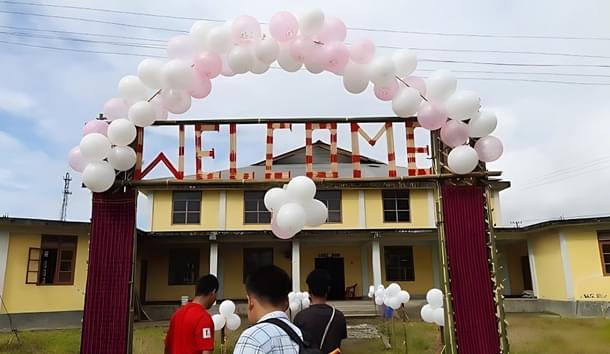
The Donyi-Polo Movement
Alongside the Rangfrah movement, the Donyi-Polo Movement has been another major force in the religious revival of Arunachal Pradesh, and unlike the previous one, has been able to achieve significant reconversions.
This movement, rooted in the belief in the Sun (Donyi) and the Moon (Polo), emerged as a response to the increasing influence of Christianity and the erosion of traditional tribal identities.
The Donyi-Polo faith is deeply embedded in the lives of the Tani tribes—Adis, Nyishis, Apatanis, Tagins, and Galos—who have long revered the celestial bodies for their life-giving properties. The formalization of this faith began in 1968, when Adi intellectuals convened to discuss ways to preserve their religious and cultural practices.
Talom Rukbo, a leading figure in the movement, was instrumental in advocating for the institutionalization of Donyi-Poloism. Rukbo argued that by organizing their religion, the Adi and other Tani tribes could reclaim their cultural heritage and resist the pressures of conversion and outside religious influences.
In the 1980s and 1990s, with the help of organizations like the Vanavasi Kalyan Ashram and the RSS, Donyi-Poloism gained momentum. The RSS played a significant role in encouraging the indigenous communities to institutionalize their faith, akin to the practices of Christianity.
Through careful engagement, they convinced tribal leaders and spiritual guides to establish congregation areas, much like churches, where people could gather for communal worship. They also encouraged the creation of idols and the development of structured rituals, similar to Christian practices like hymns and prayers, but grounded in the Donyi-Polo faith, which traditionally revolves around the worship of the sun (Donyi) and moon (Polo).
This institutionalization of the indigenous faith was seen as a way to deepen the connection to their beliefs and create a more formalized, cohesive religious identity. The idea was to help the people feel "one with God" through organized, collective expressions of worship, strengthening both their spiritual and cultural unity in the face of outside influences.
As a result, temples were constructed, religious texts were written and traditional rituals were reestablished. These efforts mirrored those of Hinduism in their institutionalization, helping Donyi-Poloism become a recognized and organized faith.
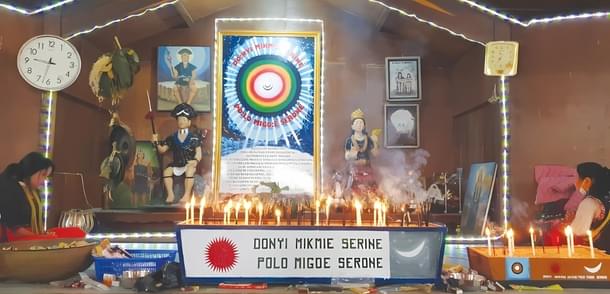
The construction of temples and prayer halls, with support from the Sangh, dedicated to the sun and moon became central to the spiritual life of the community, serving as places of worship, education and cultural activity. Similarly religious symbols were manufactured and distributed among people to be displayed in their temples and their homes.
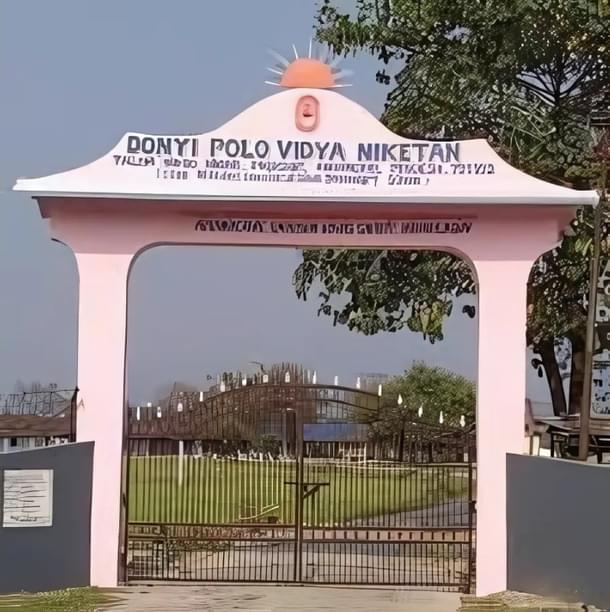
The Donyi-Polo movement also aimed to adapt to modernity while staying rooted in tradition. The Donyi-Polo Vidya Niketan schools, supported by the Vanavasi Kalyan Ashram, integrated both traditional knowledge and modern education, ensuring that the younger generation retained a connection to their ancestral faith while also equipping them with the skills needed in a rapidly changing world.
At the same time, the RSS also lobbied for the renaming of Naharlagun–Guwahati Intercity Express train to be renamed as the Donyi-Polo Express, mainstreaming the religion.

The Role of RSS and Sister Organizations
The Sangh Parivar’s efforts in promoting the indigenous faiths of Arunachal Pradesh were primarily focused on providing logistical support, resources and guidance while respecting the local leadership and initiative.
At the same time, they also played an instrumental role in infrastructure development, helping to establish prayer halls, supporting the construction of temples, and also schools and health centres.
For the RSS, the revival of indigenous faiths in the Northeast, particularly in Arunachal Pradesh, is part of a larger vision to unite the tribal communities with India’s cultural and spiritual heritage, without forcing them into the Hindu fold, which is often the criticism.
During my conversation with an adhikari (office-bearer) of Kalyan Ashram, he emphasised on the need to preserve the tribal way of life instead of exporting Vedic Hinduism. RSS Sarsanghchalak Mohan Bhagwat has often stated that indigenous faiths are the “mother of Hindutva,” emphasizing that these traditional beliefs share a deep connection with the broader spiritual and cultural fabric of India.
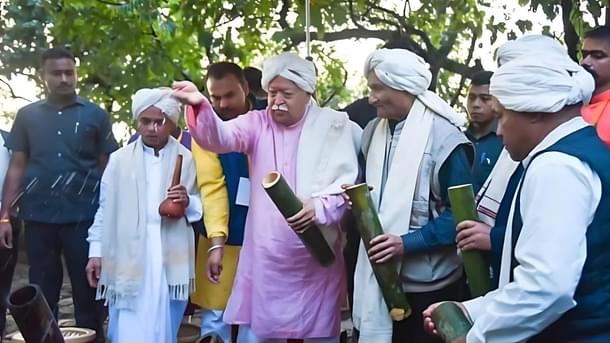
The RSS’s role, as articulated by Khimun, Rukbo and other leaders, was never about imposing a foreign ideology but rather about supporting indigenous people in reconnecting with their own traditions and identity. The Vanavasi Kalyan Ashram has also played a significant role in preserving and promoting the indigenous faiths of Arunachal Pradesh, especially in the 2000s.
They recognised that while Christian communities were visibly displaying symbols like stars and crosses, the indigenous populations lacked similar markers to symbolize their traditional faith and often felt less connected to their faith. In response, the Kalyan Ashram organized a year-long effort in the Changlang-Tirap-Longding belt and distributed items like lockets, flags and images of indigenous deities to help instill a sense of identity and pride within these communities.
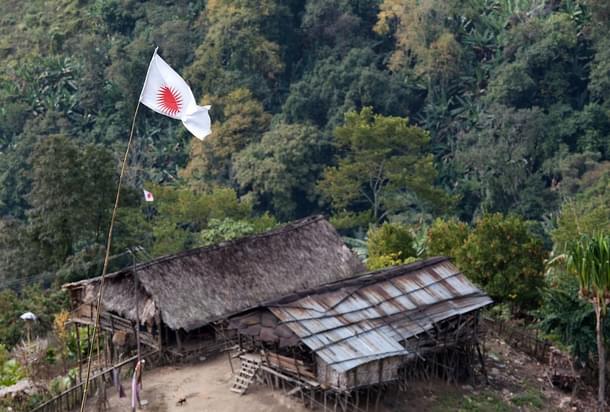
The initiative proved highly successful. Today, over 50,000 homes across 2,000 villages display their cultural and religious symbols. This communal effort involved people from all walks of life—whether doctors, professors or local villagers—coming together each evening to distribute the items.
The project not only reinforced the importance of visible symbols in fostering cultural pride but also strengthened the sense of unity and shared purpose among the indigenous people.
Another key aspect of Kalyan Ashram’s role was its involvement in religious infrastructure, particularly in the construction of temples dedicated to Rangfrah, Donyi-Polo and other indigenous deities in Changlang and Tirap. Despite significant opposition including threats and violent resistance by the NSCN, the Ashram persevered.
As a result of these concerted efforts, 26.20% of the population of Arunachal Pradesh consider themselves as belonging to indigenous faiths such as Rangfrah and Donyi-Polo. Combined with Hindus (29.04%) and Buddhists (11.77%), the total percentage of non-Abrahamic population of the state is at 67.01%.
The Story of Reslience and Revival
The revival of indigenous faiths in Arunachal Pradesh, through movements like Rangfrahism and Donyi-Poloism, is a testament to the resilience of the region’s tribal cultures.
These movements, supported by organizations like the RSS, have allowed tribal communities to reclaim their religious and cultural identities while adapting to the modern world. While critics may view the involvement of the Sangh Parivar with skepticism, the communities themselves have emphasized that this is a grassroots movement, driven by local leaders and elders.
L. Khimun, perhaps the most prominent leader of the Rangfrah movement was challenged that this newfound idol worship of Rangfrah was an attempt to Hinduise the people of Arunachal Pradesh. He famously replied, "We used to cook rice in bamboo chunga (hollow), now we use pressure cookers. But the rice remains the same," he famously remarked, emphasizing the importance of modernizing without losing one’s core identity.
In a region marked by diverse tribes, external religious pressures, and rapid social changes, these indigenous faiths offer a sense of unity and pride, affirming the rich cultural heritage of Arunachal Pradesh. As these movements continue to grow, they serve as a reminder of the importance of cultural preservation, adaptability, and the power of community-driven change.
Nabaarun Barooah is an author and commentator.





